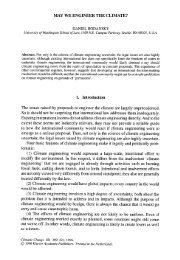ThorEA - Towards an Alternative Nuclear Future.pdf
ThorEA - Towards an Alternative Nuclear Future.pdf
ThorEA - Towards an Alternative Nuclear Future.pdf
You also want an ePaper? Increase the reach of your titles
YUMPU automatically turns print PDFs into web optimized ePapers that Google loves.
Appendix VIII:<br />
An historical UK perspective<br />
The UK was one of the first countries to develop civil nuclear<br />
power, opening the first commercial-scale grid-connected power<br />
pl<strong>an</strong>t in 1956. The four-unit Calder Hall power station served<br />
two purposes: the first was to produce plutonium <strong>an</strong>d other<br />
isotopes necessary for the UK nuclear weapons programme,<br />
whilst the second was to demonstrate the useful production<br />
of cle<strong>an</strong> electricity free from the industrial-relations difficulties<br />
<strong>an</strong>d air-pollution problems of coal-based power generation.<br />
During the Second World War the UK had been a key<br />
contributor to the US-led M<strong>an</strong>hatt<strong>an</strong> Project to develop the<br />
atom bomb. However, the 1946 US Atomic Energy Act forbade<br />
US collaboration with foreign powers, so from then the British<br />
were isolated for over ten years.<br />
The UK made <strong>an</strong> early decision to focus on plutonium-based<br />
weapons production <strong>an</strong>d this requirement motivated the<br />
development of graphite-moderated, natural-ur<strong>an</strong>iumfuelled<br />
reactors such as Calder Hall. By 1964 the UK needed<br />
to pl<strong>an</strong> for a second generation of nuclear power pl<strong>an</strong>ts<br />
following the largely successful Magnox programme; various<br />
prototype technologies were possible such as the Steam<br />
Generating Heavy Water Reactor at Winfrith in Dorset, or the<br />
Windscale Adv<strong>an</strong>ced Gas-Cooled Reactor (AGR) prototype.<br />
During the early 1960s Fr<strong>an</strong>ce chose to migrate from gascooled<br />
reactors to pressurised light-water reactors: the UK<br />
stayed with graphite <strong>an</strong>d gas, arguably making one of the<br />
worst technology policy decisions in UK history. The AGR<br />
programme suffered numerous setbacks, only some of which<br />
were technical. It was not until the late 1990s that the UK<br />
completed its first world-class light water reactor, based upon<br />
a US Westinghouse SNUPPS pl<strong>an</strong>t design: Sizewell B in Suffolk.<br />
Since Labour came to power in 1997 it is notable that nuclear<br />
energy is back on the agenda, <strong>an</strong>d that in the same period<br />
the former UK research <strong>an</strong>d fuel cycle comp<strong>an</strong>y BNFL has<br />
been systematically dism<strong>an</strong>tled. From the ashes of BNFL we<br />
have the National <strong>Nuclear</strong> Laboratory who, together with <strong>an</strong><br />
increasing number of UK universities, is pressing for future<br />
reactor build.<br />
In the context of the present report, it is interesting to note<br />
that the HELIOS experiment, commissioned in Harwell in<br />
1979, is a specific example of UK’s leadership in the field of<br />
ADSR technology. In this experiment, <strong>an</strong> electron beam from<br />
Harwell’s linear accelerator was coupled with a subcritical<br />
assembly, conforming one of the earliest examples of<br />
accelerator-driven subcritical devices (Lynn, 1980).<br />
Similarly, the UK has experience of deployment of thorium<br />
fuel: Thorium fuel elements with a 10:1 Th/Highly Enriched<br />
Ur<strong>an</strong>ium ratio were irradiated in the 20 MWth Dragon heliumcooled<br />
High Temperature Gas Reactor at Winfrith, UK, for<br />
741 full power days between 1964 <strong>an</strong>d 1973. The Th/U fuel<br />
was used to ‘breed <strong>an</strong>d feed’, so that the U-233 created from<br />
fertile Th-232 replaced the burnt U-235 at the same rate, <strong>an</strong>d<br />
fuel could be left in the reactor for about six years.<br />
Finally it is worth stating that of all the declared nuclear<br />
weapon states the UK arguably has the most unblemished<br />
record in proliferation prevention, <strong>an</strong> achievement the UK<br />
c<strong>an</strong> be proud of. The development of thorium-fuelled ADSR<br />
would help to continue this tradition.<br />
A report prepared by: the thorium energy amplifier association 61



